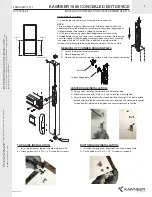
5-4
All digital input and output channels are isolated from the
backplane of the mainframe. With the mainframe in the nor-
mal display state, the status (on or off) of the output and relay
channels is displayed. When the mainframe is in the read
input channels mode, the status (on or off) of the input chan-
nels is displayed.
The hardware for the digital output channels is user config
urable for negative or positive true logic. That is, depending
on the user configuration, the output can go high or be pulled
low when the channel is turned on (closed) or off (open). To
configure output logic, refer to Section 4
Input channels use positive true logic but can be configure
to pull up or pull down. Thus, a channel can be pulled high
or pulled low when the input is open depending on the
jumper configuration. Input channels will be displayed as
high (on) when the input has a high logic level applied. Con-
versely, an input channel will be displayed as low (off) when
a low logic level is applied.
To control the card from the mainframe, each relay and
digital output must have a unique channel assignment.
The channel assignments for the card are provided in
Figure 5-6. Each channel assignment is made up of the slot
designator (1 or 2) and the relay or digital output channel.
For the Model 7002, the slot designator can be from 1 to 10
since there are ten slots. To be consistent with Model 7001/
7002 operation, the slot designator and channel are separated
by exclamation points (!). Some examples of channel
assignments are as follows:
CHANNEL 1!1 = Slot 1, Channel 1
CHANNEL 1!40 = Slot 1, Channel 40 (Output 40 of
Digital I/O)
CHANNEL 2!2 = Slot 2, Channel 2
CHANNEL 2!34 = Slot 2, Channel 34 (Output 34 of
Digital I/O)
These channels are displayed and controlled from the normal
display state of the mainframe. If currently in the menu
structure, return to the normal display state by pressing
EXIT.
Figure 5-6
Model 7037 programming channel assignments
2!1
2!2
2!3
2!4
2!5
2!6
2!7
2!8
2!9
2!10
2!11
2!12
2!13
2!14
2!15
2!16
2!17
2!18
2!19
2!20
2!21
2!22
2!23
2!24
2!25
2!26
2!27
2!28
2!29
2!30
2!31
2!32
2!33
2!34
2!35
2!36
2!37
2!38
2!39
2!40
1
2
3
4
5
6
7
8
9
10
B. Slot 2
(Card 2)
1!1
1!2
1!3
1!4
1!5
1!6
1!7
1!8
1!9
1!10
1!11
1!12
1!13
1!14
1!15
1!16
1!17
1!18
1!19
1!20
1!21
1!22
1!23
1!24
1!25
1!26
1!27
1!28
1!29
1!30
1!31
1!32
1!33
1!34
1!35
1!36
1!37
1!38
1!39
1!40
1
2
3
4
5
6
7
8
9
10
A. Slot 1
(Card 1)
Examples:
1!18 = Slot 1, Channel 18
2!36 = Slot 2, Channel 36 (Output 36, Digital I/O)
Summary of Contents for 7037
Page 7: ......
Page 33: ...Card Connections and Installation 4 14...
Page 61: ......
Page 62: ......
Page 63: ......
Page 64: ......
Page 65: ......
Page 67: ......
Page 68: ......
Page 72: ...Keithley Instruments Inc 28775 Aurora Road Cleveland Ohio 44139 Printed in the U S A...
















































